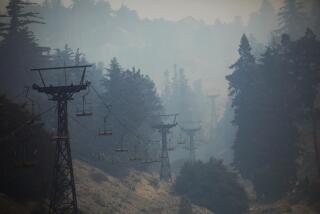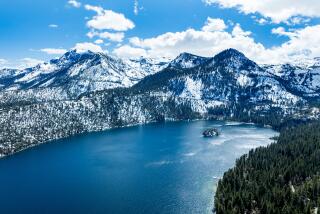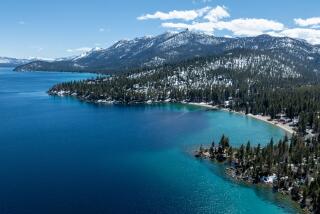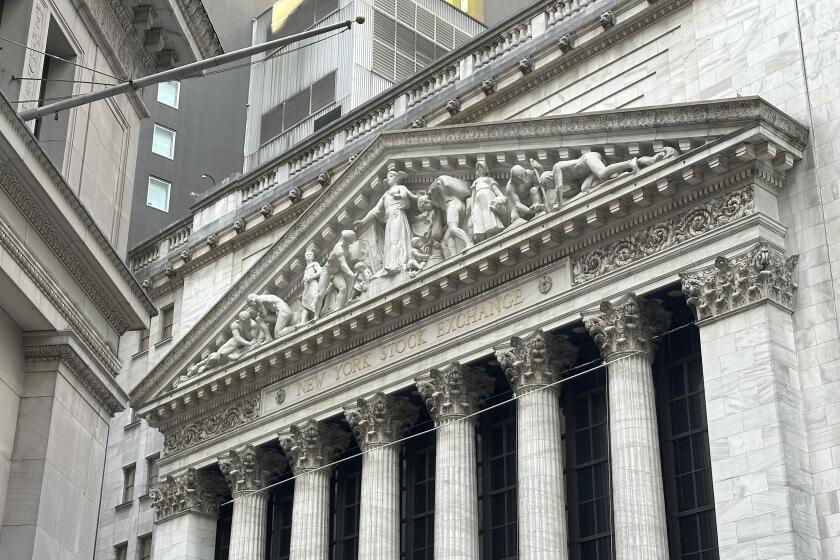Skiers and snowboarders are inundating resorts, paying higher lift prices

As mounds of fresh powder pile up on California’s mountain ranges, ski resort operators are looking for crowds of near record size — with price increases to match.
Storms have dumped up to 7 feet of snow on some peaks in as little as 48 hours.
“We are in a storm cycle that is giving us feet of snow, not just inches,” said Steven Hemphill, marketing director at the Sierra at Tahoe Resort, south of Lake Tahoe.
All of that snow has helped boost visitor numbers at California and Nevada resorts by 5% to 10% over the same time last season, according to ski industry officials.
“We have seen a lot of growth in the past few weeks,” said Evan Reece, co-founder and executive officer at Liftopia, a website that sells lift tickets for ski venues throughout North America. “We are now pacing above last year.”
Prime ski conditions this year are extending across the country, said Mike Berry, president of the National Ski Area Assn., a trade group for the country’s ski resorts. Last year’s big snowfall mostly dumped on the Western U.S., with lower accumulations in the Midwest and Eastern states.
“We are off to the best start of the season that we’ve seen in the past five or six years,” he said.
A bump in ski visits in California over last year would be significant for the $3-billion industry, considering that last season brought the best ski conditions in years. Ski resort operators attributed the crowded slopes last season to pent-up demand among snow junkies who have had to suffer through years of drought.
Ski resorts in California and neighboring Nevada reported 7.25 million skier and snowboarder visits during the 2015-16 season, a huge jump over the 4.4 million visitors in the previous drought-ravaged season, according to the California Ski Industry Assn.
But skiers and snowboarders who are itching to get on the slopes can expect to pay higher prices for season passes and one-day lift tickets.
Lift ticket prices overall have jumped 5.6% in North America this season compared with last year, Reece said. That’s on top of the 9% increase last year from the previous season.
In the eastern Sierra Nevada, a one-day adult lift ticket for Mammoth Mountain, one of the the state’s most popular ski resorts, now costs nearly $150, an increase of approximately 10% over last year.
In the San Bernardino Mountains, a one-day lift ticket for Big Bear Mountain sells for about $100, up more than 15% from last year.
Vail Resorts Inc., the nation’s largest ski resort operator, reported last month that season pass sales through Dec. 4 were running about 16% ahead of 2015’s pace.
“Our sales of season passes continue to deliver outstanding results,” Rob Katz, executive director of Vail Resorts, told analysts in an earnings conference call.
Vail’s popular Epic Pass, which offers seasonlong access to Vail resorts across the U.S., was priced at $809 this year, an increase of about 5% over last season.
But the price increases don’t seem to bother hard-core skiers, who note that they can get discounts by booking in advance or buying multiple-day tickets.
“The retail prices going up is a way of life,” said Bruce Lee, president of the Beach Cities Ski Club in Hermosa Beach. “It doesn’t effect the regular skiers as much as the casual skier.”
Other skiers say they compensate for lift price increases by doubling up on hotel rooms or condos, preparing meals at home and taking public transit to the slopes.
Pam Belitski, a longtime skier from Ventura, said she gets a discount on her season pass at Mammoth Mountain because she is a senior citizen. But the rising prices make it too expensive for her to bring her grandchildren on the slopes.
“When my sons were in middle school, ski trips were something I could afford,” she said. “It’s just a lot of money for a few times a year, nowadays.”
For ski resorts, a key to a successful year is not only the amount of snow but the timing.
Several ski resort operators in California said they had a healthy snowfall just before Christmas, followed by clear skies until the New Year’s Eve weekend. The timing of the snowstorms made for optimal ski conditions during the entire week.
“We just wrapped a successful holiday period with skier visits and snowfall totals tracking very similarly to last season during the same time,” said Lauren Burke, a spokeswoman for Mammoth Mountain Ski Areas, which operates Mammoth and June Mountain in the eastern Sierra along with Bear Mountain and Snow Summit in the San Bernardino Mountains. “January is looking to be one of the best months we’ve had in awhile.”
On the California side of Lake Tahoe, resort operators at Alpine Meadows and Squaw Valley credit higher consumer confidence for improved sales in the shops and restaurants at the foot of the mountains.
“The spending patterns have been extremely favorable,” said Andy Wirth, president and chief executive of Squaw Valley Ski Corp., which owns Alpine Meadows and Squaw Valley.
Skiers and snowboarders are also booking more hotel rooms for four- and five-day visits, compared with two- and three-day visits in years past, Wirth said.
Resort operators are hoping that Mother Nature will continue to deliver prime ski conditions deep into the spring. Wirth noted that this season will break records only if the resorts continue to get heavy snowfall over the next two months.
“We still have a long way to go,” Wirth said. “March is a pivotal month.”
To read more about the travel and tourism industries, follow @hugomartin on Twitter.
ALSO
‘A big mess’: Mammoth prepares for a monster snowstorm
How California went from drought to dangerous rain and snow
Job growth slows in 2016, but wages are rising
More to Read
Inside the business of entertainment
The Wide Shot brings you news, analysis and insights on everything from streaming wars to production — and what it all means for the future.
You may occasionally receive promotional content from the Los Angeles Times.










